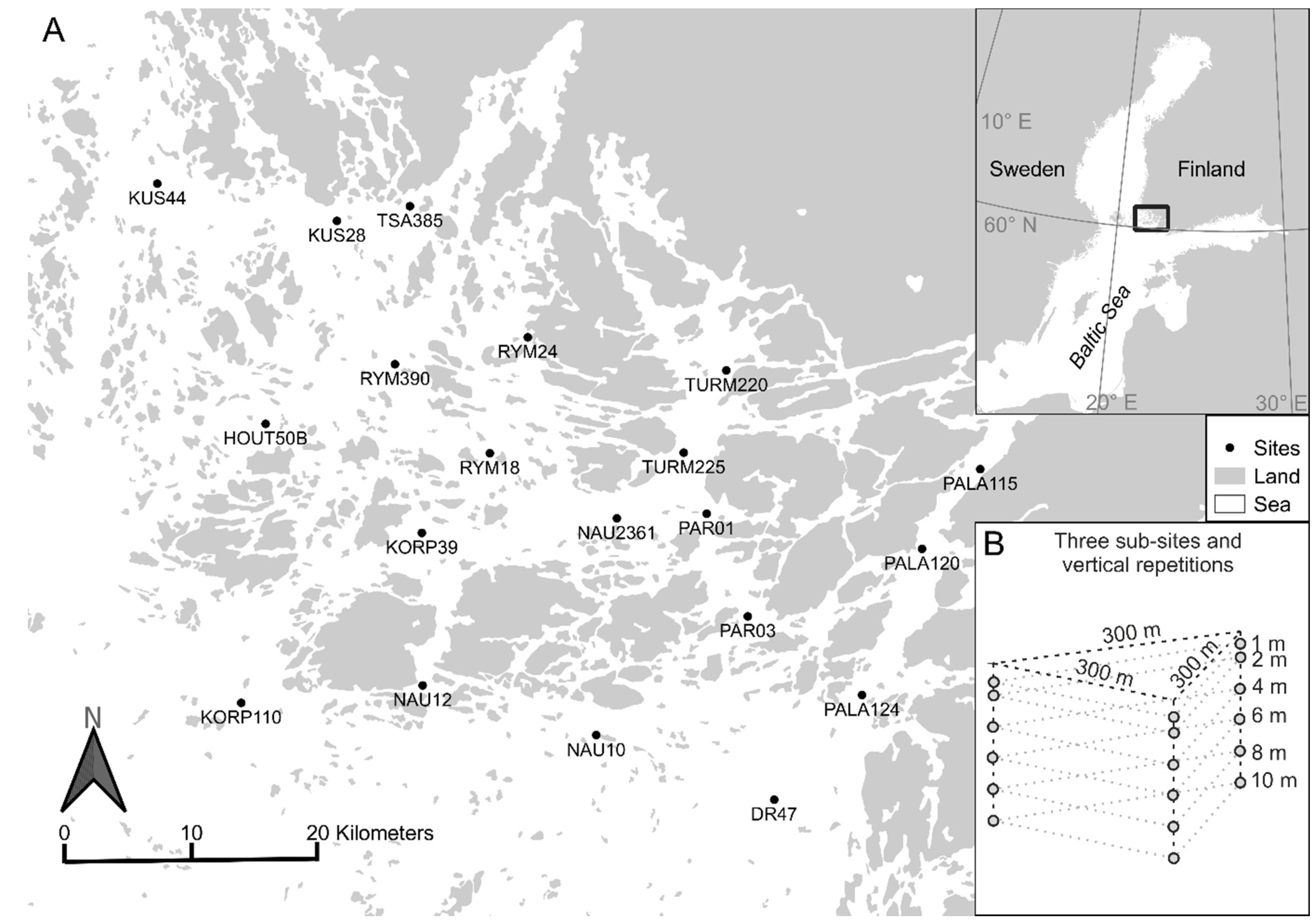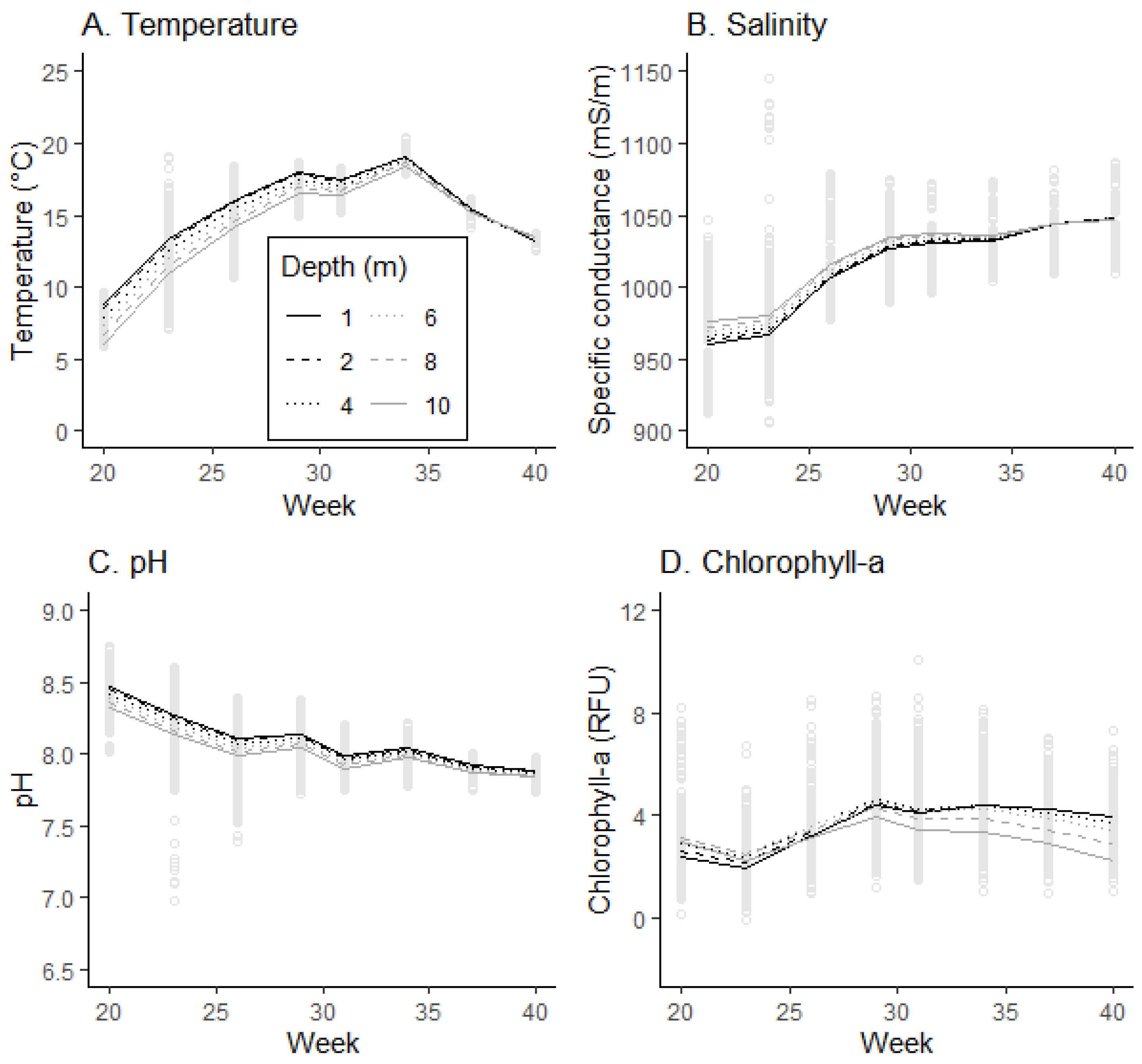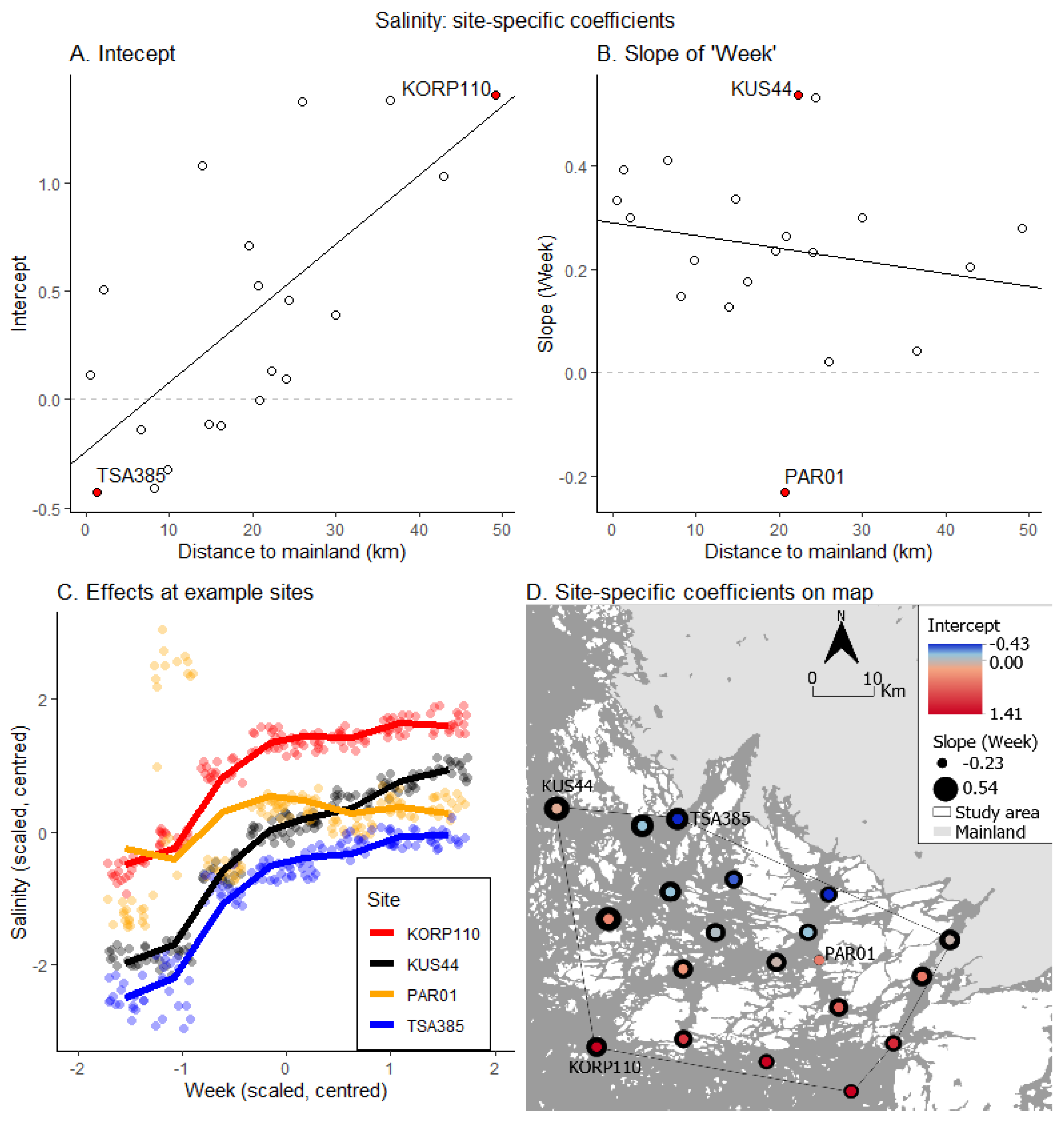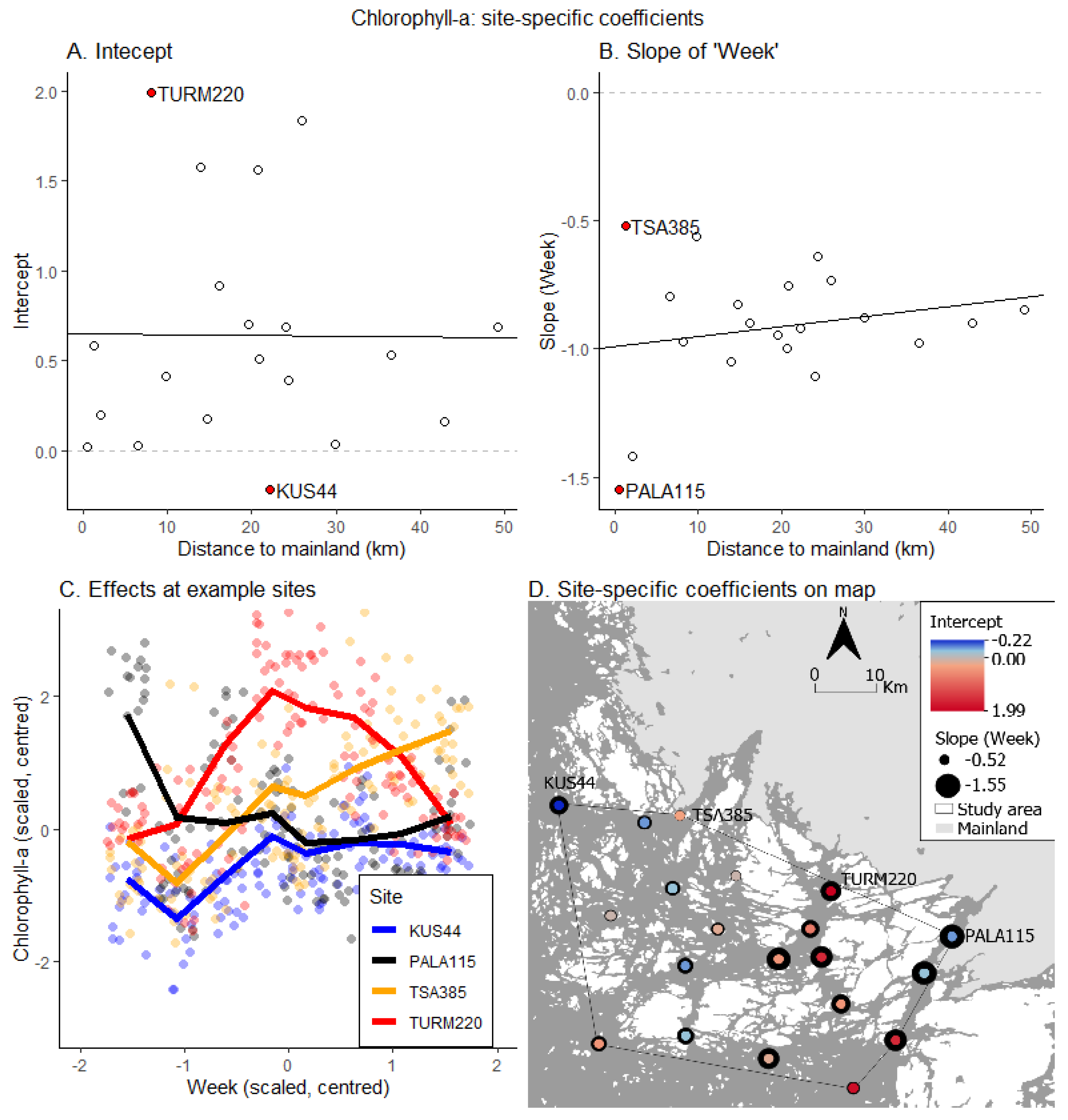1. Introduction
Coastal waters form a globally important environment at the land–sea interface, where the aquatic ecosystems are diverse, and the human influence on the sea is at its highest. Particularly in estuaries and other semi-enclosed coastal areas, the brackish water zone is often a very complex marine environment where the physicochemical processes, water flows and ecological features form dynamic and detailed patterns. However, understanding the patterns and processes of these environments is crucially important when trying to maintain and improve their ecological status, and to prepare for the impacts of global change [
1,
2,
3,
4]. A better understanding of the current status and the processes is needed to improve the science-based management of the marine archipelago environments in the future [
5,
6,
7,
8].
Coastal waters are typically complex and gradually shifting zones between the mainland shoreline and the pelagic realm. Within this zone, high local variability and temporal inconsistency in water properties often occur [
9,
10,
11,
12,
13,
14,
15], and the variation is usually different among the parameters. When monitoring the status of the coastal marine environment and the impacts of nature conservation measures, the sampling must be carefully fitted to the spatial and temporal scales of the phenomena [
9,
16], since the results of a monitoring campaign are highly sensitive to the timing and location of the sampling [
17,
18,
19,
20].
Archipelago coasts, in particular, are characterised by a notable spatial and temporal variation in water properties [
9,
10,
21]. Our study area, the SW Finnish archipelago coast in the Baltic Sea, is a good example, where small and large islands, deep basins, shallows and sills create a very complex bathymetry [
9]. The varying bathymetry causes restrictions in water exchange [
22]. In addition, the location of many archipelagos at the land–sea-interface causes local and temporal variation in marine and terrestrial influences [
23]. For example, a large component of the variability in water properties in the SW Finnish archipelago is persistent and depends on the location along the land–sea transition: Suominen et al. [
9] reported clear spatial trends in the water properties along the mainland–open sea axis.
Seasonality causes an important component of variability in water properties in higher latitudes. This includes a high annual temperature and stratification cyclicity, winter ice cover, and high variability in runoff due to snow accumulation and melting. Thus, in addition to the spatial complexity, the temporal complexity is distinct. These complexities together make brackish coastal archipelagos, such as the SW Finnish coast, very dynamic and challenging to monitor. The environmental conditions vary due to the presence of islands and shallow topography, causing the seasonal developments (i.e., timing and magnitude) of, e.g., algal growth, to differ within small areas—numerous previous studies, which have utilised in situ and remotely sensed data and spatial modelling, highlight these features in the SW Finnish archipelago in terms of spatial [
11,
24,
25], temporal [
9,
12,
26], and spatio-temporal variability [
10,
27]. Many studies conclude that the variation is difficult to capture, and it is advisable to use combined methods to complement in situ sampling (e.g., [
9,
10,
11,
12,
26]). However, to our knowledge, the four-dimensional (temporal, vertical and horizontal) patterns of water quality have not yet been statistically quantified.
This study aimed at statistically examining the scalability of water properties in space and time in a heterogeneous archipelago (
Figure 1). More specifically, we examined how the variation in archipelago water properties is divided into the temporal, vertical and horizontal dimensions (
Figure 1). We pursued this by statistically reanalysing a unique, pre-existing dataset from the SW Finnish archipelago (described in Suominen et al. [
9]). This dataset included four water property variables: temperature, salinity, pH and chlorophyll-a concentration. The measurements were repeated densely at local (10
2 m or hundreds of metres) and regional (10
4 m or tens of kilometres) scales, along the vertical gradient (topmost 10 m) and in time (three-week intervals) during one growing season (May–October). We partitioned the variation in water properties to temporal, vertical and spatial dimensions utilising multilevel modelling, to gain better understanding of the scalability of the in situ measurements of different water parameters on the archipelago coast (
Figure 1).
4. Discussion
We present a detailed examination of the variation of key water properties in horizontal, vertical and temporal dimensions on a brackish archipelago coast, based on a unique high-density dataset. Our results demonstrate that the four water properties, temperature, salinity, pH and chlorophyll-a concentration, vary significantly at temporal and vertical scales. This alone confirms that the spatio-temporal variation of water properties in a complex coastal archipelago cannot be captured by temporally and vertically sparse sampling, as also suggested by previous studies (e.g., [
9,
10]). Further, the impact of time on water properties varies notably and somewhat predictably along the vertical gradient.
Chlorophyll-a exhibits the most complex temporal and vertical patterns, including a vertical shift of the chlorophyll-a concentration (
Figure 3D and
Figure 6C). In the spring, the lowest values are measured close to the surface, and highest values at the 10 m depth, while the situation is reversed in the autumn (
Figure 3D). This indicates that there are different vertical distributions of the life cycles between the phytoplankton species occurring in the spring and in the later summer (e.g., [
43,
44]). The model captures the spring and later summer peaks in algal growth [
45], as well as a continuous increase in salinity throughout the study period.
A notable part of the variation in salinity, pH and chlorophyll-a occurs at the site level (12–34%), i.e., between locations that are several kilometres apart. Thus, salinity, pH and chlorophyll-a vary notably at the regional scale (10
4 m). Temperature varies more homogeneously at the regional scale, but finer details of the temporal–vertical patterns are site-dependant. No notable variance remains at the sub-site level. In other words, there is no local-scale (10
2 m) variation in water properties (
Table 5). These findings statistically confirm the indicative results by Suominen et al. [
9].
Instead of trying to explain why the variation among the water properties occurs, the aim of this study is to portray how the variation occurs spatio-temporally, and how it is divided into the horizontal, vertical and temporal dimensions. There are many underlying phenomena and measurable variables, such as nutrient concentrations, which regulate the chlorophyll concentration and the seasonal distribution of solar radiation, which regulates, among other things, the water temperature [
46]. Instead of coupling the drivers with outcomes, this study confirms the significance of the water property variation in all dimensions.
Multilevel modelling proves to be an appropriate statistical approach to partitioning variation in water property variables into temporal, vertical and horizontal dimensions and examining their temporal and vertical gradients in different areas. As they are designed for accounting for the spatially nested structure of observations, they would be suitable for testing hypotheses on the drivers of water properties based on such spatial data. This is because the underlying assumption of independence in observation-level modelling (standard linear regression) is not fulfilled in spatially clustered data [
33]. This is the case even if there is no significant variation between groups of observations, in this case between the sampling sites [
33]. In addition, after incorporating suitable regional-level predictor variables into the models, they would be suitable for predictive water property modelling.
The results from our multilevel modelling suggest that both the overall level and the seasonal development of water properties vary at the regional (but not local) scale. In multilevel modelling, allowing the regression coefficients to vary between sites reveals important processes, which may be masked in observation-level examination. For example, only the best multilevel model for temperature allows the effect of depth to vary between sites, revealing potentially important vertical–temporal processes. Conversely, the depth profiles of salinity, pH and chlorophyll-a are similar among the sites.
Preliminary tests using second- and third-order models perform reasonably well for temperature, salinity and pH, and capture the main seasonal trends (see
Appendix B). The more complex models (including up to seventh-order terms) are able to also capture the smaller temporal fluctuations in water properties. These preliminary findings suggest that the simpler second- and third-order models could be more suitable starting points for the predictive modelling of water properties (temperature, salinity and pH), i.e., when transferring the results into other areas and other years. The higher-order models seem to capture small-scale temporal variability of the particular observation period. These are potentially influenced by factors such as weather conditions and hydrological and oceanographic conditions.
It should be noted that national monitoring programs are designed to provide an overview of entire sea areas, and therefore they should not be expected to reveal regional-scale details. However, for example, the Finnish national program covers two (temporal and vertical) of the three relevant dimensions identified in this study: a small number of key sites (NAU2361 in our study area; see
Figure 1) are sampled frequently throughout the year, and along the depth gradient. In addition, the Finnish national program has been running uninterrupted for decades, thereby offering long time-series data that enable inter-annual comparisons. Regarding regional-scale spatial detail, our results indicate that a single sampling site does not reliably represent water properties—apart from temperature—in the entire archipelago, not even at the nearest sites included in the national monitoring network. Thus, the temporally frequent sampling at one site only represents the very local (10
2 m) surroundings at the site. In addition, national monitoring programs may involve a spatially dense but temporally sparse sampling of water properties, such as in Finland. The results of one spatially dense sample cannot be generalised to other periods of time, since the seasonal development patterns are dissimilar among the sites.
The data and methodology used in this study provide solid statistical evidence on the issue of horizontal, vertical and temporal scalability of water property measurements. The methods are applicable in coastal areas anywhere to locally examine the scalability of in situ sampling. The predictability of water properties in other years based on the multivariate models for a single year is somewhat restricted, due to year-to-year variability in weather conditions and in the Atlantic forcing. To a degree, it can be assumed that the main spatio-temporal trends persist from year to year, but the lack of detailed data for other growing seasons sets a limitation to these conclusions. Further research on this topic would benefit from multi-annual in situ time series data from a few selected sites, as well as combining high-quality remotely sensed data to in situ data [
47,
48,
49,
50].














